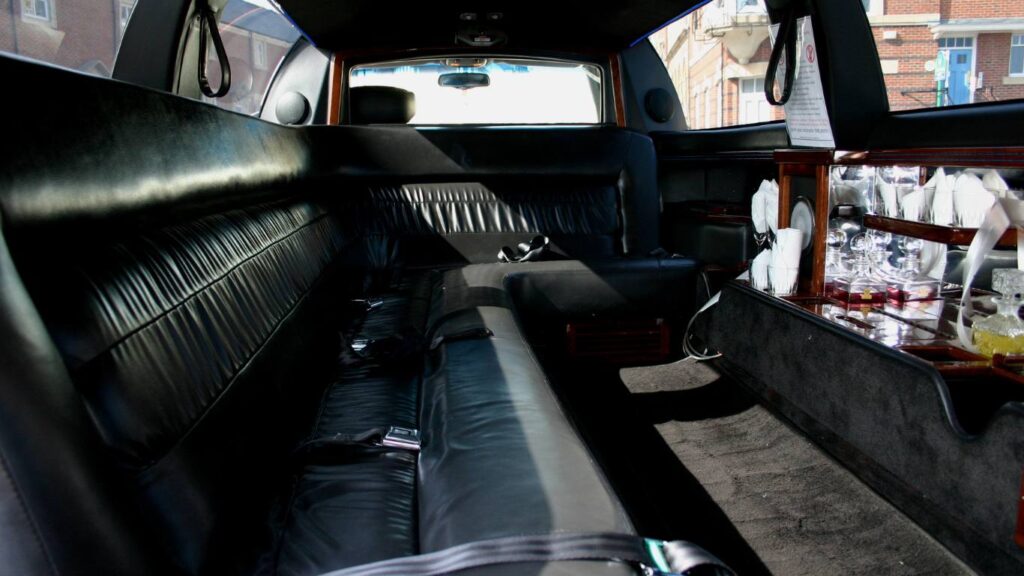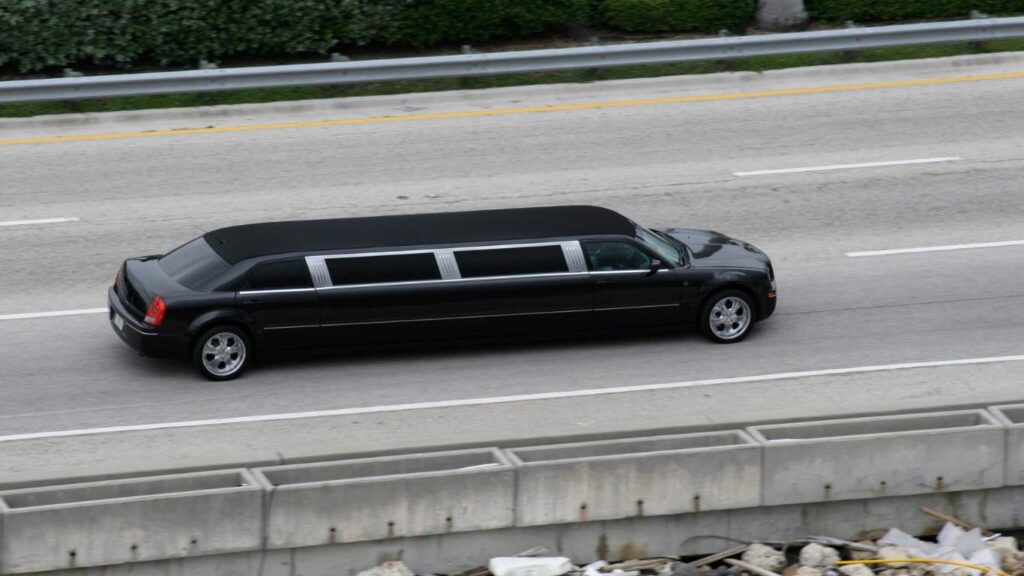Limousines are luxurious vehicles often associated with special occasions like weddings, proms, and nights out on the town. One of the most common questions people have when renting a limo is, “How many people can fit in a party bus?” The answer to the question depends on several factors, including the size and type of limousine. Depending on the limousine type a standard limousine has capacity of 6-8 passengers and larger limo, a stretch limo can accommodate 10-20 or more passengers.
Here in this blog we’ll explore the seating capacity of different limousine types, discuss the factors that determine passenger capacity, and provide insights to help you choose the right limo size for your needs or group size.
Table of Contents:
ToggleHow Many People Can Fit in a Limousine?

So, how many people does a limo hold? Larger limos can fit 10-20 passengers, while a short or classic limo can fit 4-6 passengers. Limousines come in various sizes and configurations, each with its own passenger capacity.
Below are 3 types of limousines explaining their capacity, these limousines often feature a combination of seating arrangements, including bench seats, individual bucket seats, and sometimes even additional fold-down or jump seats. Amongst them stretch limos has larger capacity.
By understanding the different limousine capacity, you can better assess your group’s needs and choose the appropriate vehicle size for a comfortable and enjoyable ride experience.
Here’s an overview of the different limousine and their capacity of how many people can fit in:
Small-Sized Limousine (3-5 Passengers)
Compact or small-sized limousines are based on standard sedan models, such as the Lincoln Town Car or Cadillac SUVs. These vehicles typically fit in 3-5 passengers, including:
- 3-passenger compact limo: Seating for the driver and two rear passengers
- 5-passenger compact limo: Seating for the driver and four rear passengers
The seating arrangement in a small-sized limousines usually consists of a bench seat in the rear compartment. Despite their smaller size, compact limos offer a luxurious ride experience, it’s best for corporate transportation and newly wed couples.
Medium-Sized Limousine (6-8 Passengers)
Medium-sized limousines, often referred to as SUV limousines, are built on larger SUV platforms like the Hummer or Escalade and these limousine seating capacity is 6-8 passengers, with seating configurations that includes:
- Captain’s chairs in the rear cabin
- Bench-style seating
- Additional jump seats or fold-down seats
The increased interior space of medium-sized limousines makes them a popular choice for small to medium-sized groups, such as business executives, families, or intimate gatherings.
Stretch Limousine (10-20 Passengers)
Stretch limousines are created by extending the chassis and body of a standard limousine, providing significantly more interior space. The stretch limousines can fit 10 to 20 passengers, depending on the specific stretch size:
- 10-passenger stretch limo
- 14-passenger stretch limo
- 20-passenger stretch limo
The capacity of stretch limousine to fit up to 20 passengers is ideal for prom night transportation, bachelor/bachelorette party, New Year eve’s transportation, and birthday party.
How Is Passenger Capacity Determined for Different Limousines?

Limousine passenger capacity is primarily determined by the vehicle’s interior configuration and overall size. It is important to know about the types of limo to accurately accommodate your guests before booking or planning a party trip. Here’s how capacity is determined for different limo types:
The Size and Layout of the Vehicle
Limos come in various sizes from small to medium to large. The overall size and interior layout of the limousine play a crucial role in determining its passenger capacity. Larger vehicles, like super-stretch limos, can accommodate more passengers than standard or compact limos.
The Number of Seats
The number of seats installed in the limousine directly impacts its passenger capacity. Limos can have various seating configurations, including bench-style seating, individual bucket seats, and sometimes even fold-down or jump seats.
The Amount of Legroom and Headroom
In addition to the number of seats, the amount of legroom and headroom available in the limo’s cabin also affects passenger comfort and capacity. Larger limos typically offer more spacious interiors, allowing for greater passenger capacity while maintaining a comfortable seating experience.
The Weight Capacity of the Vehicle
Limousines have a maximum weight capacity determined by the manufacturer, which includes the weight of the vehicle itself, passengers, luggage, and any additional amenities or equipment.
Exceeding this weight limit can compromise safety and performance, so it’s essential to consider the combined weight of the passengers when determining the appropriate limo size.
Capacity of Limousine for Different Events?
The below table will give you insights of different types of limousines and number of passengers can onboard:
| Limo Type | Size | Passengers | Best for Occasions |
|---|---|---|---|
| Classic Limousines | Small | 4-8 | Elegant events, weddings, and formal occasions |
| Holden Limousines | Small | 6-11 | Birthday parties, small gatherings |
| Ford Limousines | Small | 6-11 | Casual outings, group events |
| Dodge Nitro Limousines | Small | 8-10 | Bachelor parties, lively celebrations |
| Chrysler Limousines | Medium | 8-12 | Birthday parties, corporate events |
| Audi Limousines | Medium | 10-14 | Corporate events, upscale gatherings |
| Jeep Limousines | Medium | 12-14 | Group outings, adventurous trips |
| Hummer Limousines | Large | 10-24 | Large parties, proms, special occasions |
| Exotic Limousines (e.g., Ferrari, Rolls Royce) | Varies | Varies | Luxury events, VIP experiences, red carpet occasions |
Are There Any Regulations Regarding Maximum Limo Occupancy?

Yes, there are regulations in place regarding the maximum occupancy of limousines, and these regulations vary by state and local jurisdiction.
Most states and cities have specific laws or regulations that set the maximum passenger capacity for different types of limousines. These limits of limousine are based on factors such as the vehicle’s size, weight, and seating configuration, as well as safety considerations. For example, in California, maximum occupancy of a limo is determined by the number of seat belt installed.
Many jurisdictions require all passengers in a limousine to be properly secured with seatbelts. This means that the number of seatbelts available in the vehicle effectively determines the maximum legal occupancy.
Exceeding the maximum occupancy limits can have serious liability implications in case of an accident or incident. Limousine companies and rental services must adhere to these regulations to protect themselves and their passengers.
While there are often state-level regulations, some cities or municipalities may have additional or more stringent occupancy rules for limousines operating within their jurisdictions.
Florida Regulations Regarding Maximum Limousine Occupancy
In Florida, limousine occupancy is regulated by the Florida Department of Highway Safety and Motor Vehicles (FLHSMV). The regulations are outlined in the Florida Administrative Code, specifically Rule 15C-7.008.
According to the rule, the maximum number of passengers allowed in a limousine is determined by the manufacturer’s stated seating capacity. The limousine cannot carry more passengers than the number of factory-installed seats.
Florida law also requires that all passengers in a limousine be properly secured with a seatbelt or restraint system. The number of seatbelts effectively limits the maximum occupancy.
Limousine drivers and chauffeurs in Florida are responsible for ensuring that the vehicle is not overloaded beyond its legal capacity. Violations can result in fines or penalties.
Book a Limo That Fits All Your Guests
Whether you’re planning an unforgettable night out, a luxurious wedding celebration, or a corporate event in Miami, choosing the right limousine size is crucial for ensuring a comfortable and enjoyable experience for you and your guests.
At Miami Luxe Limo, we understand the importance of accommodating your group’s needs while adhering to safety and comfort standards. Our knowledgeable team is here to guide you through the various limousine options, from compact sedans to super-stretch vehicles, and help you select the perfect ride that fits your group size and occasion.
Contact us today to discuss your requirements, and let us take care of your transportation needs, allowing you to sit back, relax, and enjoy the ultimate luxury limousine in Miami.
Frequently Asked Questions
How many seats do limos have?
The number of seats in a limousine can vary greatly depending on the type and size of the vehicle. A compact limousine may have as few as 3-5 seats, while a super-stretch limousine can have up to 20 seats or more.
Can 20 people fit in a limo?
Yes, it is possible for 20 people to fit in a limousine. A 20-passenger stretch limousine or a 20-passenger super-stretch limousine is designed to accommodate up to 20 passengers comfortably.
Can you fit 22 people in a limo?
While it is possible to squeeze 22 people into some larger limousines, most limousine companies would not recommend exceeding the stated seating capacity for safety and comfort reasons. A 20-passenger or 30-passenger super-stretch limousine would be the appropriate choice for a group of 22 people.
What is the limit of people in a limo?
The limit of people in a limousine depends on the specific vehicle model and its stated seating capacity. Generally, the seating capacity ranges from 3-5 passengers for a compact limousine, 6-10 passengers for an SUV limousine, 10-20 passengers for a stretch limousine, and up to 40 passengers for the largest super-stretch limousines.
How many seats do limos have?
Limousines seating comes in different styles like front facing which can be found in SUVs, face-to-face which are more often found in corporate limos, and J-seat configuration which are found mostly in stretch limos. So, the number of seats a limo have are:
- Face-to-Face: 6 to 10 seats.
- Forward Facing: 8 to 14 seats.
- J-Seat Configuration: 10 to 12 seats.






